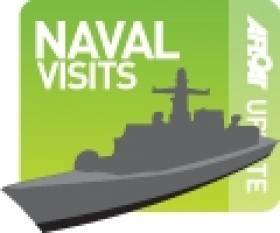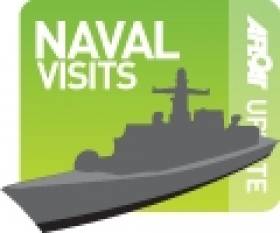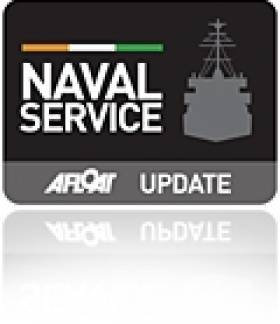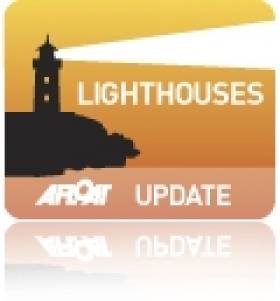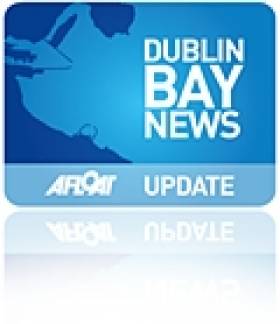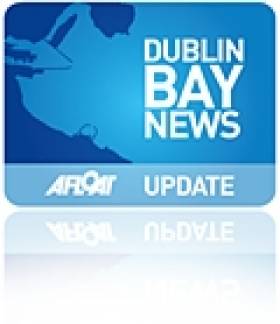Displaying items by tag: Dun Laoghaire Harbour
‘Family Fun Day’ in Dun Laoghaire
Funds raised will go to the maritime museum which is housed in the former Mariners Church, which is run by the Maritime Institute of Ireland (M.I.I.). The museum is currently closed due to continued renovation and improvement works.
There will be a 'soft launch' or 'preview' of the maritime museum from October to mark the M.I.I.'s 70th anniversary. Next year the museum is due to be officially re-opened during the Easter. The M.I.I. welcomes new members, volunteers and donations to assist in the museum. For information visit www.mariner.ie
French OPV ‘Guard-ship’ to Follow Figaro Fleet From Dun Laoghaire
The 447 tonnes OPV provides communication liaison and assistance should the forty six sailors require during the arduous race including SAR. As such the vessel can deploy a rapid response high speed RIB-craft from an internal dock-well located at the stern.
Otherwise the RIB is used to board fishing vessels as part of fishery monitoring duties and patrolling France's Exclusive Economic Zone out to 200 nautical miles (370 km). She is a Flamant class OPV and was built in 1997 by the Cherbourg based shipyard Constructions Mécaniques de Normandie. The 54m/177-ft craft is equipped with two 12.7mm machine guns.
As Dun Laoghaire is the only international port of call during the four-leg stages of the 1,695 nautical miles (3,390kms) the hosting of the Irish harbour is a welcomed boost to the sailing community and the local economy. Leading off the Carlisle Pier are pontoons where the one-design boats are moored and opposite is the East Pier jetty berth where the PSP Cormoran is docked.
Also at the East Pier is a festival market which is part of the Festival des Bateaux. The three-day festival ends tomorrow and was organised by the race-hosts the National Yacht Club, the Dun Laoghaire Harbour Company and Dun Laoghaire Rathdown County Council. For further festival details click HERE.
The presence of a foreign naval visitor to the harbour was more commonplace particularly during festivals held in the 1980's. In addition to the French, navies from Belgium, The Netherlands were regular festival participants.
- National Yacht Club
- Solitaire du Figaro
- Dun Laoghaire Harbour Company
- Dun Laoghaire Rathdown County Council
- Dun Laoghaire Harbour
- French Navy
- Festival des Bateaux
- Dun Laoghaire Harbour News
- Naval Visits
- PSP Cormoran
- Dun Laoghaire East Pier
- Dun Laoghaire pierheads
- Guardship
- Dun LaoghaireSables d'Lonne
- Vedee
- Dun Laoghaire Festivals
French Naval Vessel Escorts 'Figaro' Fleet to Dun Laoghaire
To celebrate the stopover of the four-stage 1,695 nautical mile (3,390 km) race, Dun Laoghaire Rathdown County Council, Dun Laoghaire Harbour Company and the National Yacht Club have joined forces to create the Festival des Bateaux (12-14 Aug).
A festival highlight will be a fireworks display which be held on Friday night at 10pm on the East Pier. In addition during the three-day festival programme includes live bands, street entertainment and a market on the Carlisle Pier. For more details and times of the free event go to www.dlrevents.ie
Visitors to the East Pier can take a closer view of the PSP Cormoran from the quayside where the 23 knot offshore patrol vessel (OPV) will be berthed. The Flamant class (OPV) entered service in 1997 after completion by Constructions Mécaniques de Normandie, Cherbourg, where the 477 tonnes vessel is based.
The 54m/177-ft vessel has two 12.7mm machine guns and is used for fishery monitoring, SAR and patrolling France's Exclusive Economic Zone out to 200 nautical miles / 370 km. In addition she is equipped with a high speed RIB-craft that can be deployed from an internal dock-well at the stern.
Navy’s Night-Time Detention of Belgium Fishing Vessel
In March another foreign-flagged fishing vessel, the UK registered Lynn Marie was detained on the same grounds for an alleged breach of fishing regulations by the L.E. Orla (P41). The Lynn Marie was escorted by the Peacock –class coastal patrol vessel (CPV) into Dun Laoghaire Harbour and similarly the custody of the vessel was transferred to the Gardai.
So far this year the Naval Service has carried out 852 boarding's and eight detentions of vessels off the Irish coast. In 2010 the navy conducted 1666 boarding's which resulted in warnings to 70 vessels and eight detentions.
Lecture: Dublin’s Own Titanic-The 'Tayleur'
The venue and is the Dún Laoghaire College of Further Education on Cumberland Street where a lecture series programme is run by the Genealogical Society of Ireland (GSI). For further information on other forthcoming GSI lectures: www.familyhistory.ie/
Heritage Week: Maritime Lecture Seminar Day
Below is listing of the lecture programme and times.
12.30 – 1.30 pm. Neutral Ireland's Role in the Sinking of the Bismark, May, 1941. By Dr. Michael Kennedy, Executive Editor, Documents on Irish Foreign Policy, Royal Irish Academy.
1.30 – 2.30 pm. Traditional Boats of Ireland. - Wooden workboats from all the Maritime Counties of Ireland. By Darina Tully, Lecturer and Maritime Archaeologist.
2.30 – 3.30 pm. Too Many Bags in the Lifeboat. A Lifeboat Tragedy at Bray 1876. By James Scannell, Lecturer and P.R.O of the Old Dublin Society.
3.30 – 4.00pm. Model Boats, A short talk to accompany the exhibition. By Garry Mooney secretary of the Irish Model Boat Club.
4.00 – 5.00 pm. Maritime Guinness, The Ships, Yachts and Barges of the Guinness Dynasty. By Dr. Edward Bourke, Diver, Maritime Historian and Author of "Guinness, the Family, the Business and the Black Stuff"
5.00 – 6.00 pm. Ireland's Armada Heritage. The Story of the Spanish Armada of 1588.The discoveries of the wrecks on the Irish Coast and the recovery of artifacts. By Cormac Lowth, Lecturer, Author and Diver.
For further information contact Barney Yourell Mob: 087 900 7466 No seminar charge – donations accepted
Information in general on the Maritime Institute of Ireland can be found on www.mariner.ie and for all the other events held during the National Heritage Week go to www.heritageweek.ie/
- Dublin Bay News
- Maritime Institute of Ireland
- Irish Model Boat Club
- Dun Laoghaire Club
- Dun Laoghaire Harbour
- M.I.I.
- Dun Laoghaire News
- RNLI Lifeboats
- National Heritage Week
- Heritage Week
- Maritime Lecture Seminar
- Sinking of the Bismark
- Traditional Wooden Irish Boats
- Guinness Ships
- Model Boats
- Ireland's Armada Heritage
- Spanish Armada
- Dun Laoghaire Maritime Museum
Irish Lights Appoint New Chief Executive
For the last 19 years Ms Shields has worked in the marine sector, most recently as Director of Strategic Planning and Development at the Marine Institute since 2004. In this role she had responsibility for oversight and management of the National Marine Research Programme, EU and International Policy and Programmes, Ocean Energy, Marine Technology and the Marine Data and Information Services Group of the Marine Institute.
Prior to this she held the position of Director of Science and Technology at the Marine Institute with responsibility for Research Vessel Operations, the National Seabed Survey, Oceanographic Services and the National Data Buoy Network. In addition she has worked in the marine tourism, aquaculture and private-forestry sectors.
- Ocean Energy
- Marine Institute
- Commissioners of Irish Lights
- Irish Lights
- Dun Laoghaire Harbour
- Yvonne Shields
- CIL
- Dun Laoghaire Harbour News
- National Marine Research Programme
- Marine Data and Information Services Group
- Director of Science and Technology at Marine Institute
- Marine Insitute Research Vessel Operations
Dun Laoghaire 'Needs Master Plan To Move Harbour Forward'
In a letter to The Irish Times last week, the principal of Ireland's largest sailing school hails the introduction of the new 'master plan' for Dun Laoghaire Harbour.
Alistair Rumball, director of the Irish National Sailing School (INSS), argues that the harbour's current financial model "cannot bring us forward".
He highlights the seasonal nature of the harbour's core businesses, which include a ferry service, four private yacht clubs, the Commissioners of Irish Lights (CIL) and the public marina and boat yard.
"Due to seasonality these operations cannot financially support the harbour all year," he writes. "We need the same numbers of the public to be using harbour facilities at mid- summer as mid-winter."
'Seafront Memorials' Tours of Dun Laoghaire Harbour
The tour which is free starts at the meeting point of the Queen Victoria Fountain which too forms part of the tour alongside the George VI memorial
and the Christ the King monument.
The outdoor event is part of the 'Summer of Heritage' which is organised by Dun Laoghaire-Rathdown County Council. The initiative is now in its fourth year and this year's highlight of the programme are tours of the newly renovated Seapoint Martello tower.
The coastal structure has been restored and is a fine example of these 19th century defensive forts, built along the coast to defend during the Napoleonic wars.
This summer also sees Carrickbrennan graveyard feature for the first time, the resting place of many sailors lost in maritime disasters since the 17th century.
Sightseeing along 'The Metals', a historic pathway that linked the quarry in Dalkey to the harbour in Dún Laoghaire also returns in the programme due to its popularity last year.
To read more about the the Summer of Heritage other free events in the arts, literature, sports, music and for the family, go to www.dunlaoghaire.ie/summer-of-heritage/ and www.dlrevents.ie/heritage11.html
- Events
- RNLI
- dlrcoco
- Dublin Bay News
- Dun Laoghaire Harbour
- Coastal Notes
- Dun Laoghaire News
- Seafront Memorials
- Guided Tours
- DunLaoghaireRathdown County Council
- DLR
- DLR events
- Martello Towers
- Seapoint Martello Tower
- The 'Metals'
- Queen Victoria Fountain
- King George VI monument
- Crimean War cannon
- Event news
- Napoleon
- Napoleonic Wars
- 1895 Dun Laoghaire Lifeboat Disaster
- RNLI Dun Laoghaire
- Christ the King monument
- Summer of Heritage
Seasonal Scenes Set for Fishguard
Fast-ferry Stena Lynx III departed Dun Laoghaire for Fishguard Harbour on a repositioning voyage today, writes Jehan Ashmore.
The 80m craft built in Hobart, Tasmania is due to dock at the Pembrokeshire port this afternoon in advance of seasonal sailings on Stena Line's Fishguard-Rosslare.The Stena 'Express' fast-ferry service is to resume in just over a fortnight's time. Sailings are scheduled to a daily single round trip between 1 July-4 September.
The 627 passenger / 120 car capacity fast-ferry will operate in tandem with the year-round operated conventional ferry-service served by the Stena Europe. Passage times are 120 minutes for the fast-ferry service while the Stena Europe takes 3 hours 30 minutes to sail across the St. Georges Channel.
In the same week that the fast-ferry takes up summer sailings from Fishguard, the small French flagged cruiseship Le Diament is to make the first of three calls in July and once in August.
The motoryacht-like vessel which can accommodate 226 passengers is the first cruise caller of the season and is run by the only French-owned cruise operator Compagnie De Iles Du Ponant.



























